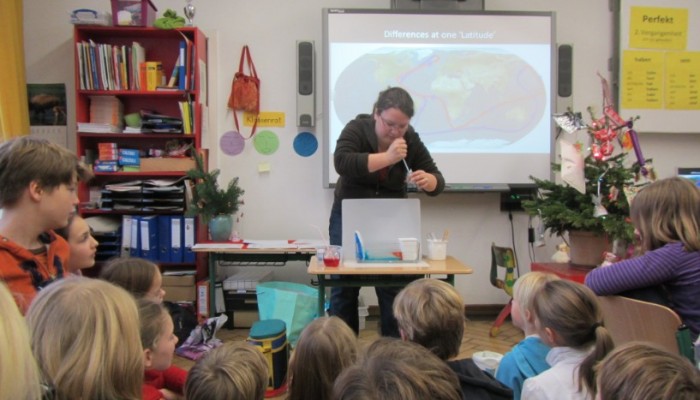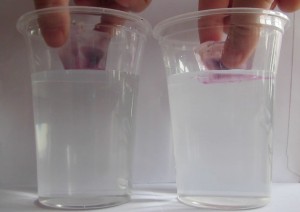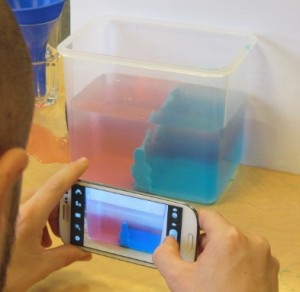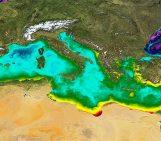
This month’s GeoEd post is brought to you by Dr. Mirjam S. Glessmer. Mirjam, is a physical oceanographer and now works as Coordinator of Teaching Innovation at Hamburg University of Technology. Mirjam blogs about her “Adventures in Teaching and Oceanography” and tweets as @meermini. Get in touch if you are interested in talking about teaching and learning in the geosciences!
“For the best hands-on outreach experiences, just provide opportunities for playing!” I claim.
Seriously? You wonder. We want to spark the public’s curiosity about geosciences, engage the public in thinking about topics as important as sea level rise or ocean acidification, and provide learning experiences that will enable them to take responsibility for difficult decisions. And you say we should just provide opportunities for them to play?
Yes. Hear me out. Playing does not necessarily equal mindlessly killing time. Kids learn a lot by playing, and even grown ups do. But if you prefer, we can use the term “serious play” instead of just “play”. Using the term “serious play” makes it clear that we are talking about “improvising with the unanticipated in ways that create new value”, which is exactly what outreach should be doing: getting people intrigued and wanting to understand more about your topic.
So how would we go about if we wanted to create outreach activities which gave the public opportunity to play in order to lure them into being fascinated by our field of science? There are several steps I recommend we take.
- Identify the topic nearest and dearest to your heart
Even if your aim is to educate the public about climate change or some other big picture topic, pick the one element that fascinates you most. If you are really fascinated by what you are showing, chances are that the excitement of doing the activity will carry over to your audience. Plus, once you have this really great activity, you will likely be asked to repeat it many times, so you had better pick one that you love! J
Me, I am a physical oceanographer. I care about motion in the ocean: Why and how it happens. Consequently, all of my outreach activities have people playing with water. Sometimes at different temperatures, sometimes at different salinities, sometimes frozen, sometimes with wind, but always with water.
- Find an intriguing question to ask
Questions that intrigue me are, for example, “do ice cubes melt faster in fresh water or in salt water?”, “how differently will ice look when I freeze salt water instead of fresh water?” or “what happens if a stratification is stable in temperature and unstable in salt?”. Of course, all these questions are related to scientific questions that I find interesting, but even without knowledge of all the science around them, they are cool questions. And they all instantly spark follow-up questions like “what would happen if the ice cubes weren’t floating, but moored to the ground?”, “what if I used sugar instead of salt?”, “wait, does the food dye influence what happens here?”. And all of those questions can be investigated right then and there. As soon as someone asks a question, you hand them the materials and let them find the answer themselves. That is why we talk about hands-on outreach activities and not demonstrations: It is about actively involving everybody in the exploration and wonder of doing scientific experiments!
- Test with family, friends and colleagues
Many, if not all, the outreach activities I am using and promoting have been tested on family, friends and colleagues before. You know that you have found an intriguing question when your friends sacrifice the last bit of red wine they brought at a Norwegian mountain cabin, to use as stand in for food dye in an experiment you just told them about, because they absolutely have to see it for themselves!
By the way, this is always good to aim at with outreach activities: always try to keep them easy enough to be recreated at a mountain cabin, in your aunt’s kitchen, at the beach or anywhere anyone who saw it or heard about it wants to show their friends. People might occasionally have to get a little creative to replace some of the materials, but that’s part of the charm and of the inquiry we want!
- Bring all the materials you need, and have fun!
And then, finally, Just Do It! Bring all your materials and start playing and enjoying yourself!
But now they can play with water and dye. That doesn’t mean they understand my research!
True, by focussing on a tiny aspect you won’t get to explain the whole climate system. But you will probably change the mindset of your audience, at least a little bit. Remember, you studied for many years to come to the understanding you have now, it is not a realistic expectation to convey all that in just one single outreach occasion. But by showing how difficult it is to even understand one tiny aspect (and how much there is still to discover), they will be a lot more likely to inquire more in the future, they will ask better questions (to themselves or to others) and they will be more open to learning about your science. Your activity is only the very first step. It’s the hook that will get them to talk to you, to become interested in what you have to say, to ask questions. And you can totally have backup materials ready to talk in more depth about your topic!
But what if it all goes horribly wrong during my activity?
The good thing is that since you are approaching the whole hands-on outreach as “get them to play!” rather then “show them in detail how the climate system works”, there really isn’t a lot that can go wrong. Yes, you can mess up and the experiment can just not show what you wanted to show. But every time I have had that happen to me, I could “save” the situation by engaging the participants in discussing how things could work better, similar to what Céline describes. People will continue to think about what went wrong and how to fix it, and will likely be even more intrigued than if everything had worked out perfectly.
But what if I am just not creative enough to come up with new ideas?
First, I bet once you start playing, you will come up with new ideas! But then of course, we don’t need to always create outreach activities from scratch. There are many awesome resources around. EGU has its own large collection in the teacher’s corner. And of course, Google (or any websearch of your choice) will find a lot. And if you were interested in outreach activity in physical oceanography specifically, you could always check out my blog “Adventures in Oceanography and Teaching”. I’m sure you’ll find the one activity that you will want to try yourself on a rainy Sunday afternoon. You will want to show your friends when they comes over to visit, and you’ll tell your colleagues about it. And there you are – you found your outreach activity!
If you want to read about how the four steps above pan out for one of my favourite outreach activities – come back to this space next month for my next GeoEd post and I’ll walk you through it! In the meanwhile tell me in the comments below – what is your best advice for doing outreach activities?
By Mirjam S. Glessmer, Coordinator of Teaching Innovation at Hamburg University of Technology







Pingback: GeoLog | GeoEd: One example of how playing works in outreach activities!
Pingback: For the best hands-on outreach experiences, just provide opportunities for playing! |